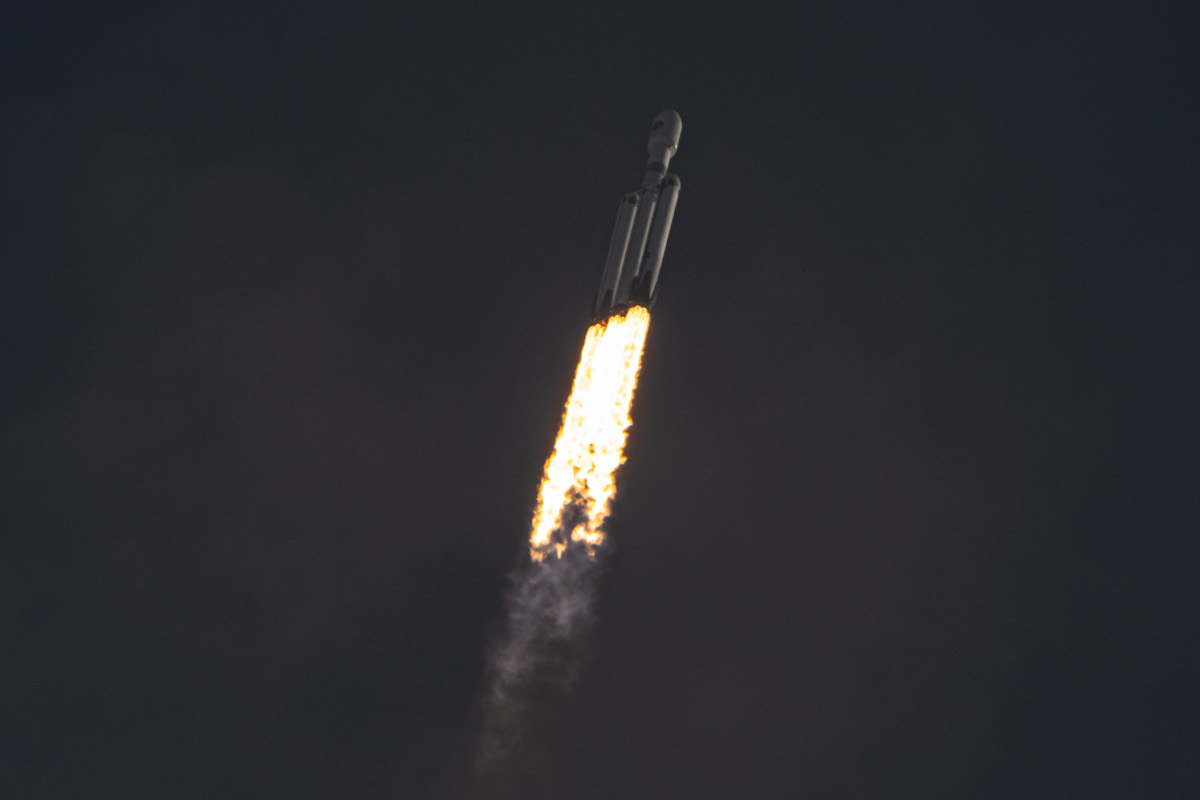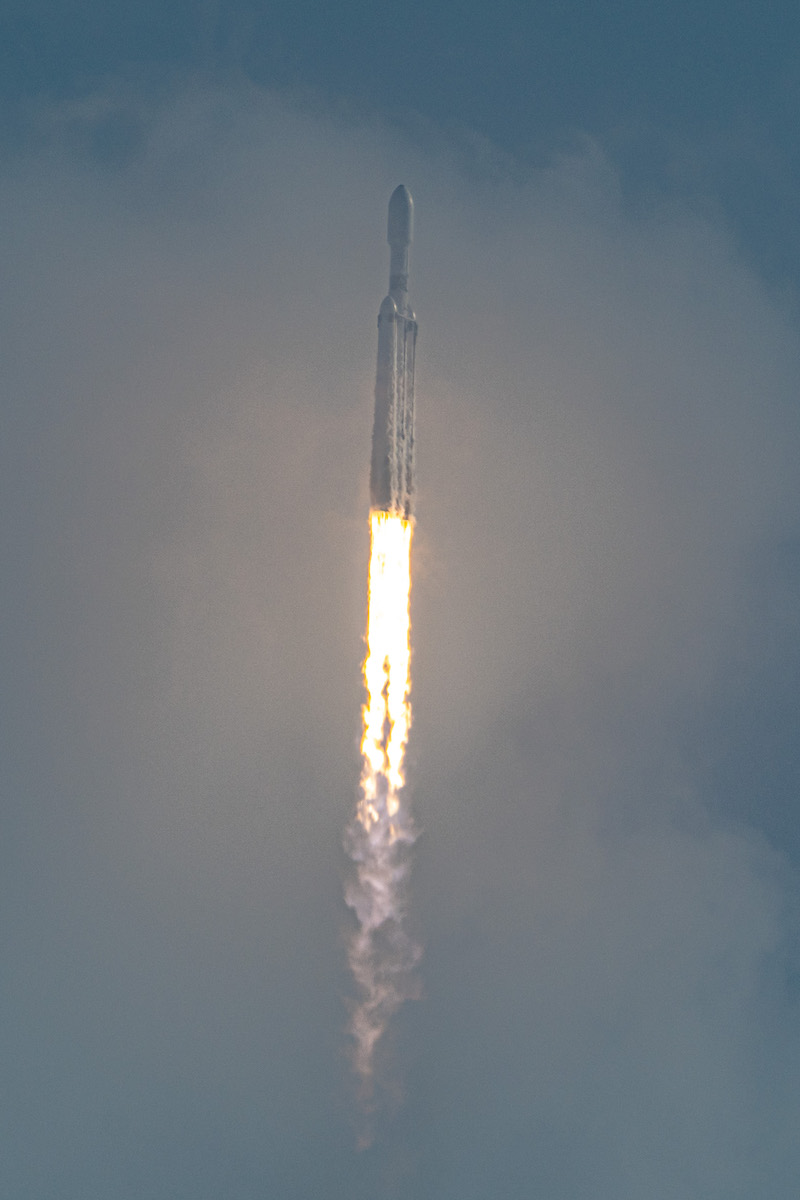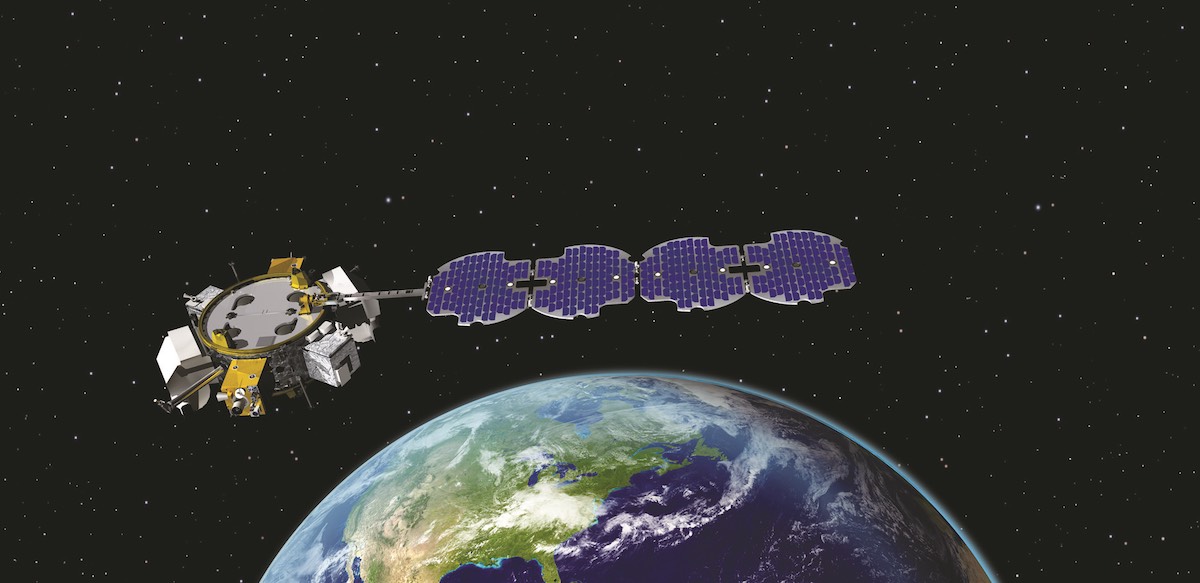
The U.S. Space Force confirmed Tuesday that a Falcon Heavy launcher placed two main payloads and at least three smaller rideshare satellites directly into a high-altitude geosynchronous orbit after liftoff from Florida, an achievement that checks off one of the final unproven capabilities for SpaceX’s rocket family.
SpaceX’s Falcon Heavy rocket, the most powerful operational rocket in the world, blasted off for the first time in more than three years from NASA’s Kennedy Space Center in Florida. It was the fourth Falcon Heavy flight overall.
“This was our first National Security Space Launch on a Falcon Heavy, and it was simply outstanding,” said Brig. Gen. Stephen Purdy, the Space Force’s program executive officer for assured access to space.
“Adding to the nation’s on-orbit capability is absolutely critical in staying ahead of the threats posed by our very active foreign adversaries,” Purdy said in a statement.
The liquid-fueled launcher, measuring 229 feet (70 meters) tall and 40 feet (13 meters) wide, fired its 27 Merlin engines at climbed away from pad 39A at Kennedy at 9:41 a.m. EDT (1341 GMT) Tuesday to begin the USSF-44 mission for the Space Force.
One of the two main payloads on the USSF-44 mission, a technology demonstration satellite called Shepherd Demonstration, is clouded in secrecy. But the Space Force disclosed in a statement after Tuesday’s launch that it will “test new technologies to enhance safe and responsible rendezvous and proximity operations.”
Technologies for rendezvous and proximity operations in geosynchronous orbit could enable new inspection, surveillance, or servicing capabilities for the Space Force. In a post-launch statement Tuesday, the Space Force said the Shepherd Demonstration mission will “accelerate risk reduction efforts” for future military space programs.
The Space Force has launched six “neighborhood watch” surveillance satellites for the Geosynchronous Space Situational Awareness Program. The GSSAP satellites are designed to maneuver to different positions in space, allowing them to track and observe other satellites. Russia and China have also launched military satellites that could be testing new anti-satellite or inspection capabilities.
The other main satellite on the Falcon Heavy rocket was the Space Force’s second Long Duration Propulsive ESPA, or LDPE 2, spacecraft, itself hosting six payloads — three that will remain attached to the spacecraft and three that will deploy from LPDE 2 to perform their own missions.
The Falcon Heavy, created by combining three SpaceX Falcon 9 rocket boosters into a single vehicle, took aim on a circular orbit some 22,000 miles (nearly 36,000 kilometers) over the equator. The high-altitude orbital destination that required more than six hours of flight from the launch pad on Florida’s Space Coast, making Tuesday’s launch the longest duration flight by a SpaceX rocket from liftoff until payload deployment.

The rocket turned east from Kennedy Space Center as it climbed above a veil of ground fog. The Merlin engines on the Falcon Heavy produced 5.1 million pounds of thrust at full throttle, around twice the power of any other operational rocket in the world. The rocket arced over the Atlantic Ocean before shedding its two side-mounted boosters two-and-a-half minutes into the flight.
The side boosters pulsed their cold gas thrusters and reignited three engines each to reverse course and begin returning to Cape Canaveral Space Force Station for landing at SpaceX’s two recovery zones about 9 miles (15 kilometers) south of pad 39A. The boosters descended to near-simultaneous vertical landings about eight minutes after liftoff.
The core stage, which throttled back its engines for the first phase of the flight, fired almost four minutes before jettisoning to fall into the Atlantic. SpaceX did not attempt to recover the center core because it devoted all of its propellant to accelerating the USSF-44 payloads into space.
An upper stage engine finished the task of maneuvering into an equator-hugging geosynchronous orbit, following a coast of some six hours through the Van Allen radiation belts before reigniting its engine and deploying the Space Force’s Shepherd Demonstration and LDPE 2 satellites.
The long-duration mission Tuesday required SpaceX to make some changes to the Falcon Heavy rocket. The most visible modification was the addition of gray paint on the outside of the upper stage’s kerosene fuel tank, which helped ensure the fuel did not freeze as the rocket spends hours in the cold environment of space.
SpaceX confirms separation of the two side boosters from the Falcon Heavy rocket. https://t.co/X96w68eOkV pic.twitter.com/RNno2VXL09
— Spaceflight Now (@SpaceflightNow) November 1, 2022
The USSF-44 payloads will orbit will orbit in lock-step with Earth’s rotation, a feature that makes geosynchronous orbit a popular location for military communications, early warning, and reconnaissance satellites.
Most satellites heading to geosynchronous orbit get dropped off by their launcher in an egg-shaped transfer orbit. That requires the spacecraft to use its own propulsion resources to circularize at an operational altitude over the equator.
Some launches deploy their satellites directly into geosynchronous orbit. The Atlas 5 and Delta 4 rockets built by United Launch Alliance, a SpaceX rival in the U.S. launch industry, have accomplished this feat before. But the launch Tuesday was SpaceX’s first attempt to place payloads directly into geosynchronous orbit.
SpaceX tested its long duration coast capability on previous flights, including the third Falcon Heavy launch on the military’s STP-2 mission in 2019, which lasted three-and-a-half hours from liftoff through the final burn of the upper stage stage engine. In December 2019, SpaceX performed a long duration six-hour coast experiment on a Falcon 9 rocket upper stage following launch of a resupply mission to the International Space Station.
The Shepherd Demonstration satellite on the USSF-44 mission is based on an “ESPA ring,” a circular structure with attachment ports for experiments and instruments, according to a Space Force spokesperson.
The LDPE 2 spacecraft was built by Northrop Grumman, and is similar to the LDPE 1 satellite launched in December 2021 on a ULA Atlas 5 rocket. LDPE 2 hosts six payloads on circumferential ports, apparently similar to the design of the Shepherd Demonstration spacecraft, and has its own propulsion system to maneuver in space. The spacecraft is capable of releasing small satellites into orbit, and a Space Force spokesperson confirmed to Spaceflight Now that three of the LDPE 2 payloads will separate as free flyers in geosynchronous orbit.
SpaceX’s Falcon Heavy side boosters have arrived back on Landing Zones 1 and 2 at Cape Canaveral Space Force Station. This completes the first flight to space for both boosters.
Back to back double sonic booms were heard across the spaceport.https://t.co/X96w68eOkV pic.twitter.com/ZRNhK4Fewe
— Spaceflight Now (@SpaceflightNow) November 1, 2022
One of the small “subsatellites” riding on LDPE 2 is Tetra 1, a small microsatellite built by Millennium Space Systems, a Boeing subsidiary. Military officials said in a 2020 statement that the Tetra 1 satellite is designed to “prototype missions and tactics, techniques and procedures in and around geosynchronous Earth orbit.”
Millennium Space Systems confirmed the Tetra 1 satellite was on the USSF-44 mission in a press release Tuesday.
The LDPE 2 host spacecraft may also carry two Lockheed Martin CubeSats on a demonstration mission to test maneuvering and navigation capabilities for future small satellites in geosynchronous orbit. The two LINUSS smallsats — short for Lockheed Martin In-space Upgrade Satellite System — were assigned to fly on the USSF-44 mission as of early 2021, according to an orbital debris assessment report published on the Federal Communications Commission’s website.
The LINUSS A1 and A2 satellites, owned by Lockheed Martin and built by Tyvak Nano-Satellite Systems, are designed to separate from the LDPE 2 spacecraft about two months after launch, then perform maneuvers using their miniature propulsion systems. After separating to a distance of several hundred miles from one another, one of the satellites will approach its companion to a range of just 160 feet (about 50 meters).
Similar to the purpose of the Shepherd Demonstration mission, the LINUSS demonstrations will test capabilities that could be used in future satellite servicing missions, or on inspector spacecraft that could approach other objects in orbit. The LINUSS mission will also demonstrate on-board high-performance image processing, smallsat propulsion, inertial measurement units, machine vision, 3D-printed components, and reconfigurable flight software, Lockheed Martin said. The company said it developed the LINUSS mission using internal funding.
The LINUSS CubeSats are about 8 inches by 8 inches by 12 inches, and weigh about 47 pounds (21.5 kilograms) at launch.
A Space Force spokesperson declined to confirm this week whether the LINUSS satellites were on the USSF-44 launch.

The Space Force says the LDPE program allows the military to more affordably send small and secondary payloads into geosynchronous orbit, helping accelerate the service’s “pivot to new, more resilient space architectures.”
“This capability has broad potential to fill capability gaps in our space systems architecture and provide helpful services for our mission partners with frequent and low-cost access to orbit,” said Brig. Gen. Tim Sejba, Space System’s Command’s program executive officer for space domain awareness and combat power.
“LDPE 2 hosts a variety of payloads that advance technology concerning communications and space weather sensing,” a Space Force spokesperson said.
The flight Tuesday was the first Falcon Heavy launch since June 25, 2019, following a series of delays encountered by SpaceX’s customers. The USSF-44 mission was delayed about two years from the original schedule of late 2020. The Space Force blamed the delay on satellite-related problems.
The next military mission to fly on a Falcon Heavy rocket, named USSF-67, will launch the LDPE 3 spacecraft and a Space Force communications satellite in tandem. That launch is scheduled for January, and will use the same Falcon Heavy side boosters flown on the USSF-44 mission, the Space Force said.
Email the author.
Follow Stephen Clark on Twitter: @StephenClark1.
